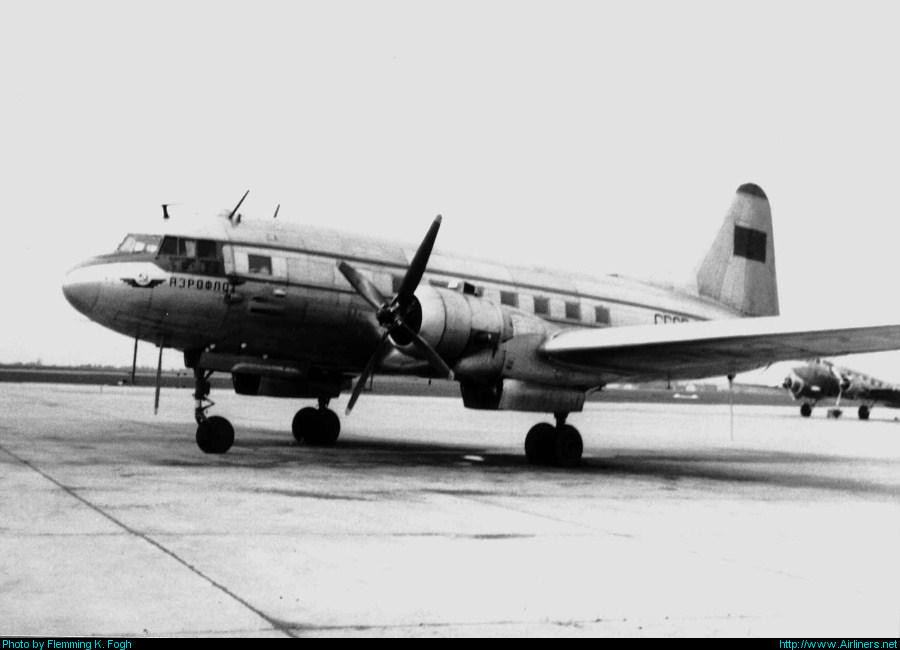
Russia license built the Douglas DC-3, since 1936 as Lisunov Li-2; however, during WW II the Soviet’s race for independence from the Western countries prompted Ilyushin to design an all-Soviet-built Lisunov replacement in 1943.
As there were no official specifications, Ilyushin design bureau “guesstimated” the market expectations and the project was developed as a private venture.
The idea was to propose a metallic, multi-engine transport monoplane with an improved tricycle landing gear allowing for a better ground visibility and cargo loading.
A TURBULENT DESIGN
Initial design, approved by Stalin in 1944, featured a significantly bigger aircraft, powered by 4 M-88 radial engines and 29 seats into a pressurised fuselage. However, shortly after the design was changed into a more compact aircraft with just two Charomskiy ACh-31 liquid-cooled (!!) engines, non-pressurised fuselage and a seat number in the figure of 20.
Only one prototype was built and flown on August 15, 1945. Unfortunately, several issues with the engines development force Ilyushin to re-engine the prototype with a more common Shvetsov M-82 radial engines.
Flight tests revealed an outstanding performances, somehow better than the Li-2 ones, and the first evaluation model was delivered to Aeroflot in early 1947.
The enthusiasm was sky high and Ilyushin decided to start mass production quite speedy after the first tests. Several versions for civil and military transport were produced setting the marker at a respectable 663 aircrafts out of the lines.
RELIABLE? WELL, NOT EXACTLY
Since the testing phase, the IL-12 shown some design problems; the sometimes extremely vibrating fuselage, having poor engine out characteristics and requiring a strut under the rear fuselage to prevent tipping during loading due to centre-of-gravity problems. The use of magnesium near the engines nacelles proved to be a bad choice as, in some engine fire cases, the material accelerated the flames quickly expanding the area on fire and extending to the wing. A later incident happened during the operational life of the aircraft provided the chance to introduce a fleet-wide modification.
Field operations shown relatively quickly that plane has certain deficiencies, particularly regarding problems with handling in certain parts of flight envelope, as well as with reliability and extremely short service life of the engines. These issues, despite extensive amount of effort aimed at curbing them, let to much shorter period of operational use and fewer operators of Il-12 compared both to it’s predecessor (Li-2) and direct successor (Il-14).
A SHORT LASTED OPERATIONAL HISTORY

After being publicly revealed on May 1st 1947, when a group of aircraft participated in the annual flyby over Red Square in Moscow, the aircraft entered active service with Aeroflot in June 1947 and operated the longest Moscow-Khabarovsk route in the airline’s network with 5 intermediate stops. She was flown internationally either within URSS than to Western destinations, such as Paris, in the Mid-50s and seen a good market in URSS countries as well as China. Poland, Czechoslovakia and Romania were among the top countries operating the IL-12 in their national’s fleets. However, the 21 passengers seat configuration widely used by the Civil airlines proved un-economic on the long-term.
A suitably modified version if IL-12 supported the Soviet’s Antarctica expeditions from 1956 on.
In the 70s almost all of the IL-12 were grounded and put out of fleets, last country to retire the type was China in the late 1980s.
SAFETY RECORDS
A total of 58 occurrences involving the Ilyushin IL-12 are recorded into the Aviation Safety Network Database, of which 56 are hull-losses.
